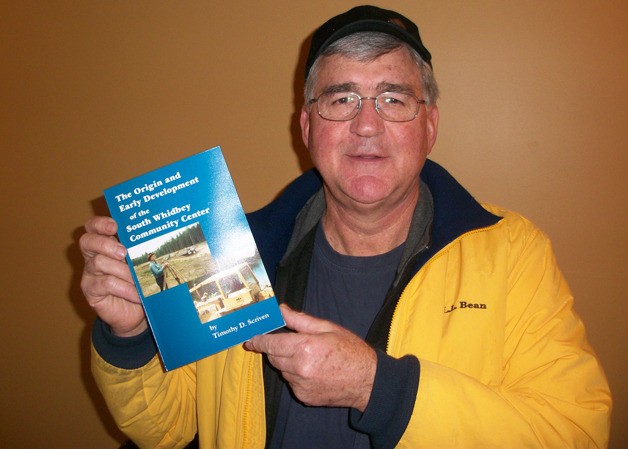It may never cross the minds of people enjoying the ballfields, playgrounds, trails or picnic facilities, but all these facilities didn’t just happen. The South Whidbey Park & Recreation District’s roots date back to the ‘70s, and one of the prime movers of the movement has written a book so that many of those involved will always be remembered.
“The Origin and Early Development of the South Whidbey Community Center,” by Timothy D. Scriven, recalls those days in words and pictures, providing a trip back in time for those involved, and perhaps creating appreciation for their efforts by newer residents of South Whidbey.
The last elected link to the effort is Jim Porter, who still sits on the board of the South Whidbey Parks & Recreation District, an outgrowth of what was originally a private venture called South Whidbey Community Center, which acquired 43 acres from timberland owner and philanthropist Bud Waterman in 1981. That in itself followed years of planning and promotion, mostly led by Scriven.
“It was a community thing,” Porter recalled this week. “Tim first came to me in the summer of ‘72 or ‘73. There were a tremendous number of hours involved, people raking, throwing sticks in burn piles, and Tim was a good seller of all that — he was the initial driver of it and the continuing driver of it.”
Clearing the newly logged land was a task in itself. Volunteer Hanford Thayer did much of the engineering, volunteer Ross Jacobson did much of the lawyering, and scores of families took up rakes and hoes to smooth the future park area. Owners of heavy equipment, among them Randy Bradley, spent hours clearing the site next to what was then the new South Whidbey High School. Also, the Navy Seabees from Oak Harbor came down to eradicate hundreds of stumps that marred the area. Chainsaw artists provided signs and artwork.
All the time, Scriven was preaching the concept of the Community Center to anyone who would listen and eliciting letters of support from businesses and elected officials. His book lists the 48 charter members of South Whidbey Recreation, who paid $250 each. It’s a who’s who of South Whidbey society at the time.
The parks and recreation district has grown greatly since those days, and now includes land along Langley Road featuring soccer fields, a playground and trails connecting it to the original land, which has a playground, baseball and soccer fields, skate park and picnic area. It’s run by five elected board members with a number of employees.
Scriven is still involved, this time making sure history is not forgotten. The South Whidbey Historical Society, with help from island resident Craig Williams and Dr. Mark Sherman at Western Washington University, has it posted on its website. And now there’s a book.
“It is my hope that this story will inspire other projects for the community to benefit from,” writes Scriven, who now lives in Burlington. “Nothing provides greater life for the community than helping children to fulfill their potential.”
Scriven plans to have the book for sale at various South Whidbey locations, including the Historical Society. Right now, it can be acquired by contacting Village Books, 360-671-2626 or brendan@villagebooks.com.



